Enjoying the content on 3QD? Help keep us going by donating now.
Category: Recommended Reading
Concern over Google ending ban on AI weapons
Lucy Hooker & Chris Vallance at the BBC:
 Google’s parent company lifting a longstanding ban on artificial intelligence (AI) being used for developing weapons and surveillance tools is “incredibly concerning”, a leading human rights group has said.
Google’s parent company lifting a longstanding ban on artificial intelligence (AI) being used for developing weapons and surveillance tools is “incredibly concerning”, a leading human rights group has said.
Alphabet has rewritten its guidelines on how it will use AI, dropping a section which previously ruled out applications that were “likely to cause harm”.
Human Rights Watch has criticised the decision, telling the BBC that AI can “complicate accountability” for battlefield decisions that “may have life or death consequences.”
In a blog post Google defended the change, arguing that businesses and democratic governments needed to work together on AI that “supports national security”.
Experts say AI could be widely deployed on the battlefield – though there are fears about its use too, particularly with regard to autonomous weapons systems.
More here.
Enjoying the content on 3QD? Help keep us going by donating now.
Wednesday Poem
Sensual
The word “sensual” is not intended to bring to mind
quivering dusky maidens or priapic black studs.
I refer to something much simpler and much less
fanciful. To be sensual, is to respect and rejoice in
the force of life, of life itself, and to be present
in all that one does, from the effort of loving to the
breaking of bread.
Something very sinister happens to the people of a
country when they begin to mistrust their own
reactions as they do here, and become joyless
as they as they have become. It is this individual
uncertainty on the part of white American men and
women, this inability to renew themselves at the
fountain of their own lives, that makes the discussion,
of any conundrum—any reality, so supremely difficult.
The person who distrusts himself has no touchstone
for reality— for this touchstone can only be oneself.
Such a person puts between himself and reality nothing
less than a labyrinth of attitudes, historical and public,
that do not relate to the present any more than they
relate to the person. Therefore, whatever white people
do not know about Negroes reveals, precisely what they
do not know about themselves.
by James Baldwin
from The Fire Next Time
Dell Publishing, New York, 1962
Enjoying the content on 3QD? Help keep us going by donating now.
Dozens of new obesity drugs are coming: these are the ones to watch
Elie Dolgin in Nature:
 For Kristian Cook, every pizza box he opened was another door closed on the path to overcoming obesity. “I had massive cravings for pizza,” he says. “That was my biggest downfall.” At 114 kilograms and juggling a daily regimen of medications for high cholesterol, hypertension and gout, the New Zealander resolved to take action. In late 2022, at the age of 46, Cook joined a clinical trial that set out to test a combination of the weight-loss drug semaglutide — better known by its brand names, Ozempic or Wegovy — and an experimental drug designed to preserve muscle while shedding fat.
For Kristian Cook, every pizza box he opened was another door closed on the path to overcoming obesity. “I had massive cravings for pizza,” he says. “That was my biggest downfall.” At 114 kilograms and juggling a daily regimen of medications for high cholesterol, hypertension and gout, the New Zealander resolved to take action. In late 2022, at the age of 46, Cook joined a clinical trial that set out to test a combination of the weight-loss drug semaglutide — better known by its brand names, Ozempic or Wegovy — and an experimental drug designed to preserve muscle while shedding fat.
Muscle loss is a big concern for people on anti-obesity medications such as semaglutide. These ‘GLP-1 agonists’ mimic a natural gut hormone — glucagon-like peptide 1 — to suppress appetite and regulate metabolism. But reducing calories leads to an energy deficit, which the body often makes up for by burning muscle. The experimental drug that Cook received, called bimagrumab, seems to counteract this muscle loss.
It’s one of more than 100 anti-obesity drug candidates that are in various stages of development. The next wave of medications, which are likely to hit pharmacy shelves in the next few years, resemble drugs that are already on the market. But close behind are numerous therapies being developed specifically for their muscle-sparing weight-loss potential. Dozens more are aimed at different biological pathways and could redefine obesity treatment in decades to come.
More here.
Enjoying the content on 3QD? Help keep us going by donating now.
Maya Angelou One More Round Woman Work
More here. (Note: In honor of Black History Month, at least one post will be devoted to its 2025 theme of “African Americans and Labor” throughout the month of February)
Enjoying the content on 3QD? Help keep us going by donating now.
Tuesday, February 11, 2025
Among The Post-Feminists
Grazie Sophia Christie at The Point:
 Women have always had a special relationship with lies; often, we have relied on them for survival. But it was the aspirational feminism of the 2010s—individualistic, empowering, breathless, especially after SoulCycle—which first introduced many of us to the art of lying to ourselves.
Women have always had a special relationship with lies; often, we have relied on them for survival. But it was the aspirational feminism of the 2010s—individualistic, empowering, breathless, especially after SoulCycle—which first introduced many of us to the art of lying to ourselves.
In those years, women followed a noble ethics—or a maladaptive one, depending on who you asked. We tried to live by the rules of how things should be, rather than how things are. The premises from which we were not to budge could be found in children’s books. Like “boys and girls are made of much the same, except for little things.” Or that girls can “be anything … even president,” as one 2019 book put it, quoting Hillary Clinton after she learned otherwise. Misogyny was a feedback loop that would keep running unless we intervened in it: systemic, embedded in all our expectations and validated each time we played along. Since our actions and speech could either reinforce misogyny or undermine it, feminists fought the patriarchy conceptually, with the right words and behavior. We would not flirt at speed traps or interviews.
more here.
Enjoying the content on 3QD? Help keep us going by donating now.
The Power Of The Moving Image
Peter B. Kaufman at the LARB:
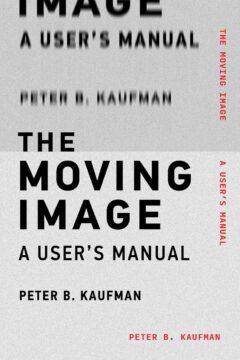 QUIETLY, ALMOST ELUSIVELY, video has become the dominant medium of human communication. There are hundreds of billions of cameras out in the world filming as you’re reading this article. Two-thirds of global internet traffic is video; that number continues to climb. If we date print back to 1455 and Gutenberg’s Mainz Bible, and the moving image to the Lumière brothers’ first public screening in Paris in 1895, print has had a 440-year head start. But Americans now get their news and information more often through screens and speakers and video-enabled media platforms than via ink on paper.
QUIETLY, ALMOST ELUSIVELY, video has become the dominant medium of human communication. There are hundreds of billions of cameras out in the world filming as you’re reading this article. Two-thirds of global internet traffic is video; that number continues to climb. If we date print back to 1455 and Gutenberg’s Mainz Bible, and the moving image to the Lumière brothers’ first public screening in Paris in 1895, print has had a 440-year head start. But Americans now get their news and information more often through screens and speakers and video-enabled media platforms than via ink on paper.
Even though the moving image has reached this juncture so quickly—indeed, perhaps because it has gotten here so quickly—there have been no mainstream usage guides that respect its leading role in our culture and our knowledge ecosystem or the rapidity with which it has arrived. There have been no popular manuals of style that focus on how we should be using video in modern communication, which is to say, how we should best be producing it, citing it, distributing it, and ultimately archiving and preserving it, especially given the vital roles it now plays in knowledge dissemination and in politics, culture, and society.
more here.
Enjoying the content on 3QD? Help keep us going by donating now.
ByteDance’s new AI creates realistic videos from a single photo
Michael Nuñez at Venture Beat:
ByteDance researchers have developed an AI system that transforms single photographs into realistic videos of people speaking, singing and moving naturally — a breakthrough that could reshape digital entertainment and communications.
The new system, called OmniHuman, generates full-body videos that show people gesturing and moving in ways that match their speech, surpassing previous AI models that could only animate faces or upper bodies.
“End-to-end human animation has undergone notable advancements in recent years,” the ByteDance researchers wrote in a paper published on arXiv. “However, existing methods still struggle to scale up as large general video generation models, limiting their potential in real applications,”
The team trained OmniHuman on more than 18,700 hours of human video data using a novel approach that combines multiple types of inputs — text, audio and body movements. This “omni-conditions” training strategy allows the AI to learn from much larger and more diverse datasets than previous methods.
More here.
Enjoying the content on 3QD? Help keep us going by donating now.
The Story of Advice
Alexander Stern at The Hedgehog Review:
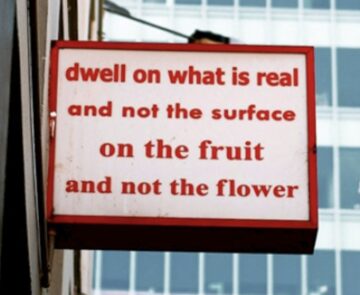 In a column for The Point magazine, Agnes Callard, a philosopher and professor at the University of Chicago, comes out against advice. She makes her case using an anecdote involving the novelist Margaret Atwood. Asked about her advice for a group of aspiring writers, Atwood is stumped and ends up offering little more than bromides encouraging them to write every day and try not to be inhibited. Callard excuses Atwood’s banality, blaming it on the fundamental incoherence of the thing she was asked to produce.
In a column for The Point magazine, Agnes Callard, a philosopher and professor at the University of Chicago, comes out against advice. She makes her case using an anecdote involving the novelist Margaret Atwood. Asked about her advice for a group of aspiring writers, Atwood is stumped and ends up offering little more than bromides encouraging them to write every day and try not to be inhibited. Callard excuses Atwood’s banality, blaming it on the fundamental incoherence of the thing she was asked to produce.
Advice, for Callard, occupies nebulous terrain between what she terms “instructions” and “coaching.” “You give someone instructions,” she writes, “as to how to achieve a goal that is itself instrumental to some…further goal,” whereas “coaching…effects in someone a transformative orientation towards something of intrinsic value: an athletic or intellectual or even social triumph.” The problem with advice, according to Callard, is that it tries to reduce and condense the time-intensive, personal work of coaching into instructions:
The young person is not approaching Atwood for instructions on how to operate Microsoft Word, nor is she making the unreasonable demand that Atwood become her writing coach. She wants the kind of value she would get from the second, but she wants it given to her in the manner of the first. But there is no there there.
Atwood, Callard writes, might tell a story about her own development as an author, but those particulars would not amount to anything like universal wisdom a young writer could integrate into her own life.
More here.
Enjoying the content on 3QD? Help keep us going by donating now.
Sean Carroll’s Mindscape Podcast: James Evans on Innovation, Consolidation, and the Science of Science
Sean Carroll at Preposterous Universe:
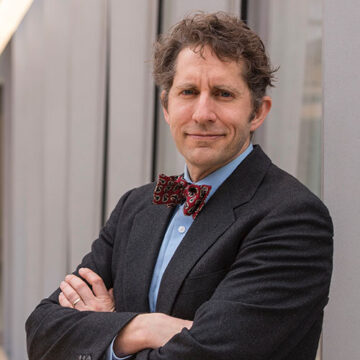
It is a feature of many human activities – sports, cooking, music, interpersonal relations – that being able to do them well doesn’t necessarily mean you can accurately describe how to do them well. Science is no different. Many successful scientists are not very good at explaining what goes into successful scientific practice. To understand that, it’s necessary to study science in a scientific fashion. What kinds of scientists, in what kinds of collaborations, using what kinds of techniques, do well? I talk with James Evans, an expert on collective intelligence and the construction of knowledge, about how science really works.
More here.
Enjoying the content on 3QD? Help keep us going by donating now.
New evidence we’re close to extinction from AI with Stephen Fry
Enjoying the content on 3QD? Help keep us going by donating now.
Five Former Treasury Secretaries: Our Democracy Is Under Siege
Robert E. Rubin, Lawrence H. Summers, Timothy F. Geithner. Jacob J. Lew and Janet L. Yellen in the New York Times:
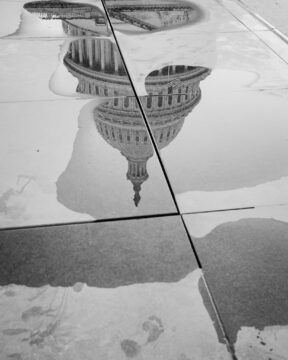 We were fortunate that during our tenures in office no effort was made to unlawfully undermine the nation’s financial commitments. Regrettably, recent reporting gives substantial cause for concern that such efforts are underway today.
We were fortunate that during our tenures in office no effort was made to unlawfully undermine the nation’s financial commitments. Regrettably, recent reporting gives substantial cause for concern that such efforts are underway today.
The nation’s payment system has historically been operated by a very small group of nonpartisan career civil servants. In recent days, that norm has been upended, and the roles of these nonpartisan officials have been compromised by political actors from the so-called Department of Government Efficiency. One has been appointed fiscal assistant secretary — a post that for the prior eight decades had been reserved exclusively for civil servants to ensure impartiality and public confidence in the handling and payment of federal funds.
These political actors have not been subject to the same rigorous ethics rules as civil servants, and one has explicitly retained his role in a private company, creating at best the appearance of financial conflicts of interest. They lack training and experience to handle private, personal data — like Social Security numbers and bank account information. Their power subjects America’s payments system and the highly sensitive data within it to the risk of exposure, potentially to our adversaries. And our critical infrastructure is at risk of failure if the code that underwrites it is not handled with due care.
More here.
Enjoying the content on 3QD? Help keep us going by donating now.
James Baldwin v. William F. Buckley (1965) | Legendary Debate
More here. (Note: In honor of Black History Month, at least one post will be devoted to its 2025 theme of “African Americans and Labor” throughout the month of February)
Enjoying the content on 3QD? Help keep us going by donating now.
Honoring Black Labor Leaders
Christian Collins in Clasp:
“Turning a blind eye to our history has not saved us from its consequences.” – Cicely Tyson
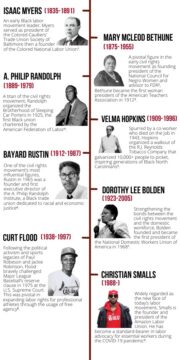 Black History Month is a time to reflect on the central role of Black people in shaping this nation. Nowhere is that more evident than the labor movement. A founding tenet of American capitalism and our economy is that Black bodies are worth more than Black minds. This belief is continually demonstrated by the value placed on Black workers and their work. During the COVID-19 pandemic, Black workers risked their lives in essential jobs to keep the country operating. And in doing so faced an increased likelihood of falling victim to COVID-19. Systemic racism and labor market segregation cause Black workers to be disproportionately employed in essential jobs – jobs that don’t provide adequate health care coverage or paid sick leave, exacerbating COVID-19’s risks. Black women in particular have continued to be ignored in the economic recovery from the pandemic, as the dual threats of racism and sexism persist, largely unacknowledged by policymakers.
Black History Month is a time to reflect on the central role of Black people in shaping this nation. Nowhere is that more evident than the labor movement. A founding tenet of American capitalism and our economy is that Black bodies are worth more than Black minds. This belief is continually demonstrated by the value placed on Black workers and their work. During the COVID-19 pandemic, Black workers risked their lives in essential jobs to keep the country operating. And in doing so faced an increased likelihood of falling victim to COVID-19. Systemic racism and labor market segregation cause Black workers to be disproportionately employed in essential jobs – jobs that don’t provide adequate health care coverage or paid sick leave, exacerbating COVID-19’s risks. Black women in particular have continued to be ignored in the economic recovery from the pandemic, as the dual threats of racism and sexism persist, largely unacknowledged by policymakers.
Black History Month’s reflections are only beneficial if we are honest. Modern America’s economic superpower status has long been attributed to the grit and ingenuity of white European settlers building the nation from the ground up, but this narrative is at best a half-truth. Black labor is the cornerstone of U.S. global hegemony. From the slaves who were brought to the shores of Virginia in 1619, through the industrialization of the United States powered by Black workers and families fleeing the South, and by the continued reliance on mass incarceration to produce a cheap workforce for corporations and governments to exploit, the commodification of Black bodies has been the American capitalist formula for economic profit.
More here. (Note: In honor of Black History Month, at least one post will be devoted to its 2025 theme of “African Americans and Labor” throughout the month of February)
Enjoying the content on 3QD? Help keep us going by donating now.
Tuesday Poems
The Strand
The dotted line my father’s ashplant made
On Sandymount Strand
Is something else the tide won’t wash away.
The Sharpening Stone
He walked on air himself, never more so
Then when he had been widowed and the youth
In him, the athlete who had wooed her—
Breasting tapes and clearing the high bars—
Grew lightsome once again. Going at eighty
on the bendiest roads, going for broke
At every point-to-point and poker school,
‘He commenced his wild career’ a second time
And not a bother on him. Smoked like a train
And took the power mower in his stride.
Flirted and vaunted. Set fire to his bed.
Fell from a ladder. Learned to microwave.
………………………… .
So set the drawer on freshets of thaw water
And place the unused sharping stone inside it:
To be found next summer on a riverbank
Where scythes once hung all night in alder trees
And mowers played dawn scherzos on the blades,
Their arms like harpists’ arms, one drawing towards,
One sweeping the bight rim of the extreme.
by Seamus Heaney
from The Spirit Level
Farrar Straus Giroux, New York, 0996
Enjoying the content on 3QD? Help keep us going by donating now.
Monday, February 10, 2025
Shakespeare vs Wittgenstein: the fight for meaning
William Day at the IAI:
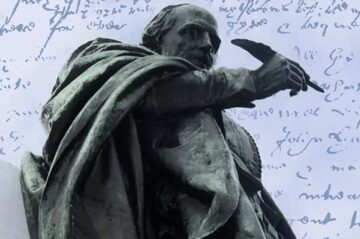 The most striking assertion in Wittgenstein’s critique of Shakespeare may be this, written in 1946: “Shakespeare’s similes are, in the ordinary sense, bad. So if they are nevertheless good – & I don’t know whether they are or not – they must be a law to themselves.” What makes Wittgenstein think he can lay claim to such a judgment? Part of the answer may lie in Wittgenstein’s own remarkable talent for similes and figures of comparison. Given their importance to his way of doing philosophy, it shouldn’t surprise that he was good at making them, and knew he was good.
The most striking assertion in Wittgenstein’s critique of Shakespeare may be this, written in 1946: “Shakespeare’s similes are, in the ordinary sense, bad. So if they are nevertheless good – & I don’t know whether they are or not – they must be a law to themselves.” What makes Wittgenstein think he can lay claim to such a judgment? Part of the answer may lie in Wittgenstein’s own remarkable talent for similes and figures of comparison. Given their importance to his way of doing philosophy, it shouldn’t surprise that he was good at making them, and knew he was good.
Here is one example, drawn from a remark he thought to include in the Foreword to the Investigations: “Only every so often does one of the sentences I am writing here make a step forward; the rest are like the snipping of the barber’s scissors, which he has to keep in motion so as to be able to make a cut with them at the right moment.” Compare this marvelous image – revelatory both of its author and of the process of writing, so often felt as a movement without forward motion – to a Shakespearean metaphor that Wittgenstein once mentioned to a friend, from Richard II. There Mowbray says, “Within my mouth you have engaol’d my tongue / Doubly portcullis’d with my teeth and lips.” Part of Wittgenstein’s critique of Shakespeare’s figures might be the obviousness of such an image as the teeth and lips as a gate for the tongue, even when one acknowledges that here it is closed to keep something in rather than to keep something out.
More here.
Enjoying the content on 3QD? Help keep us going by donating now.
Evolution vs Ethics – Peter Singer (2011)
Enjoying the content on 3QD? Help keep us going by donating now.
How AI Might Take Over in 2 Years
Joshua Clymer at X:
 I’m like a mechanic scrambling last-minute checks before Apollo 13 takes off. If you ask for my take on the situation, I won’t comment on the quality of the in-flight entertainment, or describe how beautiful the stars will appear from space.
I’m like a mechanic scrambling last-minute checks before Apollo 13 takes off. If you ask for my take on the situation, I won’t comment on the quality of the in-flight entertainment, or describe how beautiful the stars will appear from space.
I will tell you what could go wrong. That is what I intend to do in this story.
Now I should clarify what this is exactly. It’s not a prediction. I don’t expect AI progress to be this fast or as untamable as I portray. It’s not pure fantasy either.
It is my worst nightmare.
It’s a sampling from the futures that are among the most devastating, and I believe, disturbingly plausible – the ones that most keep me up at night.
I’m telling this tale because the future is not set yet. I hope, with a bit of foresight, we can keep this story a fictional one.
More here.
Enjoying the content on 3QD? Help keep us going by donating now.
Life In The Deserts Of Central Asia
Nick Hunt at Noema Magazine:
 MIZDARKHAN, Uzbekistan — On a hill at the edge of the desert stands a wooden edifice above a simple tomb. It consists of four slanting poles that come together in a frame, inside of which are bundled sticks that resemble kindling. It seems a puzzling marker for a grave until you learn the legend of whose body lies inside: Gayōmart, the first human, neither woman nor man, who was created from mud by the Zoroastrian god Ahura Mazda. Zoroastrians venerate fire, so the structure makes sense. It is a symbolic beacon waiting for its flame.
MIZDARKHAN, Uzbekistan — On a hill at the edge of the desert stands a wooden edifice above a simple tomb. It consists of four slanting poles that come together in a frame, inside of which are bundled sticks that resemble kindling. It seems a puzzling marker for a grave until you learn the legend of whose body lies inside: Gayōmart, the first human, neither woman nor man, who was created from mud by the Zoroastrian god Ahura Mazda. Zoroastrians venerate fire, so the structure makes sense. It is a symbolic beacon waiting for its flame.
Not far away, past crumbling graves and cairns of mud bricks stacked in sevens — an auspicious number in the comparatively recent religion of Islam — stands another monument, a ruined mausoleum. Its roof long ago collapsed, and only three slumped walls remain. According to tradition, one brick falls from it every year. It is dedicated to Khalif Erejep, a medieval Sufi saint, but pious Muslims believe it is built on top of Adam’s grave, a cosmological rival to the tomb of Gayōmart.
more here.
Enjoying the content on 3QD? Help keep us going by donating now.
Carlo Rovelli: Come with me Inside a Black Hole
Enjoying the content on 3QD? Help keep us going by donating now.
